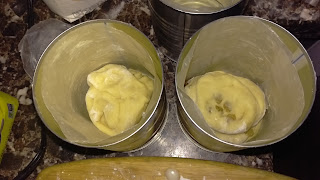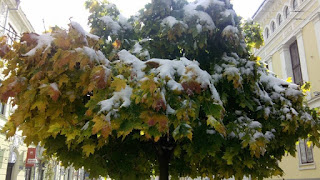Hey guys! Here is my photo report on my first ever Easter Bread or as we call it in Ukraine - Paska.
The recipe is pretty simple and there are not too many ingredients: 2 pounds of flour (I haven't figured out which flour is better: self-rising or all-purpose, this time I used self-rising), stick and a half of butter, 6 yolks and 3 eggs, a cup of sugar (can be a bit more since the US sugar is less sweet than Ukrainian), one bag of yeast, one box of raisins (I mean the bigger one), cup and a half of milk.
Now, let's go step by step:
Sift the flour even if the package says it's already been sifted since in the process of sifting flour gets saturated with oxygen and it makes the dough fluffier.
With a mixer beat the yolks and eggs into a foam (I have no clue how people lived without mixers, hallelujah to technical progress!)
Take milk, slightly warm it up, just a bit, then add a teaspoon of sugar and a bag of yeast (yeast likes sugar and warm liquids)
Cut a stick and a half of butter like that
and melt it in a microwave like that (or in any other way you know)
Add eggs, yeast mix and butter to the flour
and start mixing all that together
after a couple of minutes, the dough will stop sticking to your hands. Keep kneading the dough for at least 15 minutes and form a ball out of it.
Let it sit in warmth for one hour, but don't put in on any heated surface, cover it with some clean kitchen cloth.
In an hour it will increase at least two times.
Let's have some veggies! Just kidding, I bout these big cans to use as baking cups since Paska should have a certain form. In Ukraine, I could buy special baking cups in a supermarket, here in the US I had to use my creativity )))
A proof that I did take all veggies out )))
I cut out bottoms of wax paper so that my Paska didn't stick in the process of baking.
So you cut off a piece of dough, make it flat and put as many raisins as you like. You can put other stuff like dried pineapples or cranberries or anything else you like. I prefer raisins, A LOT of raisins ))
Then you roll the dough like this and cut it in half in the middle
Put your roll into the can and flatten it at the bottom so that the dough takes 1/3 of the can
I had way more dough than just for 3 cans so I made some other things out of it. Next, you cover the forms again and let them sit for another hour.
Warm up the oven to 370F and put the Paska inside. Bake for 30 minutes. I can tell you that there is a big difference between baking yeast dough in an electric stove and a gas one. I prefer gas ovens, but I have an electric at this point.
TADAAAAM!!! Not exactly what I expected, I wanted my Paska to grow higher, but as I've mentioned at the beginning, I picked self-rising flour and I'm not sure whether it's a good choice for yeast dough. But, there will be another year and another experiment with all-purpose flour. Maybe even sooner than next year )))
Bon appetite, and Jesus is Risen! He is risen indeed! Христос Воскрес! Воістину Воскрес!
Have a great weekend and behave!

























































